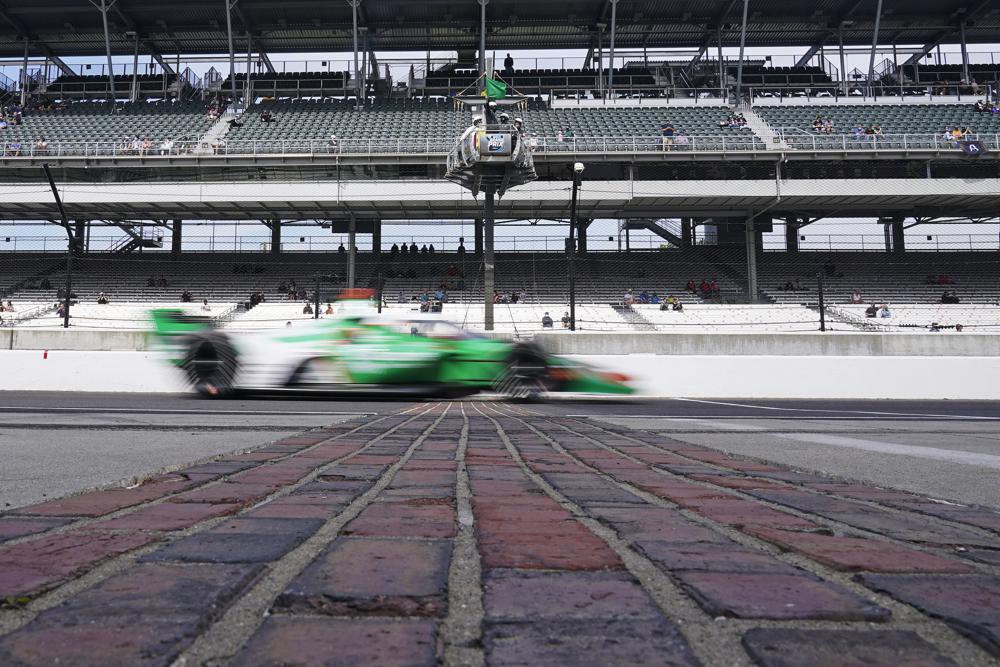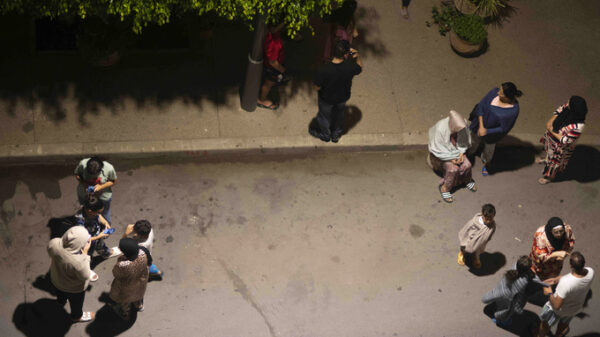James Hinchcliffe, of Canada, drives down pit lane during a warm-up session for the IndyCar auto race at Indianapolis Motor Speedway, Saturday, May 15, 2021, in Indianapolis. (AP Photo/Darron Cummings)
INDIANAPOLIS (AP) — Rod Reid ran a program full of young, Black kart racers locked out of a venue because of the pandemic and needing a track to race.
Indianapolis Motor Speedway had spent millions on upgrades on the historic property at the same time last year when the coronavirus had a steely grip on the nation. There was no guarantee — even if gates were open — that there would be room for NXG Youth Motorsports ’ usual spot teaching kids STEM classes in a makeshift classroom in the paddock or for their drivers to race around the cone-lined course in a parking lot.
The suggestion was made to Reid: Why not dial up the new boss at IMS?
His plea for help last June to Roger Penske — Reid noted the 2,300 kids from 11 to 15 years old who have passed through the school over 15 years looking for a path into motorsports — turned instead into a startling revelation for the Captain.
Yes, the NXG kids needed a place to learn and hone their craft. But the blossoming drivers also represented a rare chance for a minority group severely underrepresented in racing to feel at home inside the sprawling, 111-year-old speedway.
“We told him what we were about and he was really surprised,” Reid said. “He did not know we existed. The reason we started, especially the idea of exposing the Black community to Indianapolis Motor Speedway, surprised him because he said he couldn’t believe people don’t feel welcome here. I told him, you’re talking years and years and years back to when a person of color couldn’t even go to the speedway.”
The 84-year-old Penske offered NXG space at IMS to resume the program and, essentially, a new start. He helped NXG start a working relationship with Chevrolet, and the program secured loans to purchase a truck for its trailer. The talks with Penske happened to come not long after the death of George Floyd, a catalyst that in part led to IndyCar’s “Race for Equality and Change” initiative supporting diversity and inclusivity across the industry.
“I think the idea that a group of people would not feel welcome in a place he purchased, and a sport he loves, like I do, totally didn’t make sense to him,” Reid said.
Much like NASCAR dealt with its own racial reckoning last year, IndyCar moved to create a more diverse workforce throughout all levels of a series that has had just two Black drivers race in the Indy 500, its showcase annual event that dates to 1911. Willy T. Ribbs became the first Black driver to start the race in 1991 (and again in 1993) and George Mack in 2002 are it.
“Isn’t it sad, all these years and not another Black driver?” Reid said.
The 66-year-old Ribbs, who drives this summer for the Superstar Racing Experience series, said he never cared much for his role as Indy 500 trailblazer.
“It did not matter. I didn’t care about it,” he said. “Still don’t. It meant nothing. I was focused on going fast and trying to win. If you focused on anything other than that when you were there, you were going to get hurt or get killed.”
Programs launched over the last several months are designed to reach far beyond the cockpit, but an anchor of IndyCar’s plan was the creation of Force Indy, an all-Black race team led by Reid that competes in the IndyCar ladder USF2000 Series. Force Indy hired and developed Black mechanics, engineers and drivers throughout its entire team. Myles Rowe, who turns 21 in June, drives for the team and has been pegged as a potential Indy 500 driver.
Jimmie McMillian, chief diversity officer for Penske Entertainment, is the architect intent on designing a new era in the open wheel series. He said members of the Black community who live near IMS treat never having attended an Indianapolis 500 as some sort of badge of honor. They have an up-close look at one of the most famous venues in sports and don’t really see anyone who looks like them, certainly not on the starting grid.
“We want to make sure our paddock represents the fan base that we hope to have,” McMillian said. “My No. 1 goal, I feel every day, is to get rid of the concept that this is a white sport and that people are not welcome here.”
Years before Penske assumed stewardship of the series, IndyCar had a diversity committee that worked on recruitment and retainment for both the series and IMS. While McMillian viewed the number of women involved on the corporate side as a positive for the series — roughly 35% to 40% of the workforce are women — the minority makeup “was where we probably struggled.”
“We tried to figure out why we were so monolithic in our employee base,” McMillian said.
IndyCar’s solution was an attempt to become more aggressive and creative in its outreach efforts — how does it find the best and brightest in urban communities and persuade them to seek a career inside the paddock. Yes, there was a greater presence on social media and ticket drives, and some of the usual promotional pushes like working with key stakeholders in the community such as the Indianapolis Urban League.
For McMillian, it was the 1-to-1 connection, the personal stories that could be shared with kids and adults that Indianapolis Motor Speedway was as welcoming to them as any other fan enjoying a pork tenderloin sandwich as cars zip past at 200 mph on race day.
“How successful could you be as a person of color if you don’t see people who are successful?” McMillian asked. “So it’s telling that story and going out to different communities to say, not only do we want you here, but there’s different paths of success for you and your race doesn’t matter. This is a great place to work.”
McMillian changed tires and performed oil changes working at a Bloomington, Indiana, tire dealer in the late 1990s when his co-workers invited him to a NASCAR race at the Brickyard. He was instantly in awe at the scene of packed crowds and fast cars but Confederate flags and “South Will Rise Again” T-shirts made him uncomfortable and sowed doubts about pursuing a career in motorsports.
He’s now leading a charge for change.
IndyCar didn’t necessarily have a moment like NASCAR faced last year when Black driver Bubba Wallace led the demand for the stock car series to finally ban the Confederate flag from its races and venues.
IndyCar kept an eye on how NASCAR added minority owners like Michael Jordan and Pitbull, and McMillian said there was even more to study from NHRA: The drag racing series has long been a leader in diversity and essentially made gender, race — and even socioeconomics — nonfactors in pursuing a career in motorsports.
That hasn’t always been the case in IndyCar.
“I knew that I was not dealing on a level playing field,” Ribbs said. “I was not getting the same opportunities based on one thing, and not because I couldn’t win. I was not getting support because I was African-American. Support meaning from corporate America.”
With few exceptions for drivers born into legacy families, pursuing a career in racing is as much about sponsorship, cash and connections as talent, and the hustle is part of the job. IndyCar took a deeper look at identifying businesses willing to support developmental teams or help in securing equipment for up-and-coming programs. That also means developing a career path in racing for women and minorities in a variety of jobs outside the cockpit ranging from race engineers to public relations and sponsorship selling and beyond; Reid is a former member of the whistle-blowing, yellow-shirted security team.
“Some people say having a driver in a car is going to make all the difference in the world but if you listen to Lewis Hamilton, he’s very adamant about the fact that when he gets out of the car and goes to the Mercedes paddock, all the faces don’t look like him,” McMillian said, referring to the seven-time Formula One champion, who is Black. “His success has not changed that. I have the same concern, quite frankly, that if we were successful enough to have the Lewis Hamilton of IndyCar, that alone would not be the thing we need to really bring the change into the sport that we need.”
IndyCar created incentives for teams and track promoters that pushed diversity efforts. NXG students will race karts in Detroit as part of a pilot program that could lead to a full-season schedule in 2022 and expansion of the program is planned across the country.
NXG, funded in part through Lucas Oil sponsorship, has yet to send a student to IndyCar, though there may be no better time for kids to feel like they can succeed in some capacity at IMS.
Penske is engaged at every level and, yes, diversity can be good for the bottom line, but he has taken a hands-on approach with ideas that could spark fundamental change in the sport.
“He says, what can we do, let’s get it done,” McMillian said.
Look around IMS and tangible culture change is happening now. USF2000, the first rung on the road to IndyCar, raced at IMS during the IndyCar Grand Prix weekend ,and more Black fans seemed to visit the track and watch the race than McMillian could remember.
“They said, ‘I didn’t know so many Black people came to races,’” he said. “The narrative now is, there are a lot of Black people here. We have to make sure all the folks in our community, for one reason or another can say, ‘I’ve been to the track.’”
Copyright 2020 Associated Press. All rights reserved.





























You must be logged in to post a comment Login